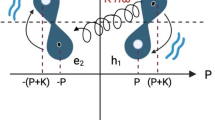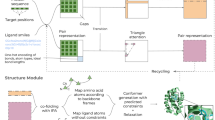Abstract
There are growing indications that the inherent curvature of DNA is important in protein–DNA recognition (for reviews see refs 1–3). The 10.5-base-pair (bp) periodicity of some dinucleotides first found in eukaryotic DNA sequences4,5 was interpreted as the expression of curvature of periodic segments of double-stranded DNA, the curvature resulting from co-orientation of periodically spaced 'wedges' between stacked base pairs. The wedge can be decomposed into roll and tilt components, opening towards a groove and a backbone respectively (Fig. 1a), both contributing to DNA curvature (Fig. 1b and c). The largest wedge was estimated to belong to the AA·TT dinucleotides. Recent work6,7 provided new experimental data on synthetic curved DNA. The authors tried to apply the wedge model to their results and met problems in doing so. We have found that taking into account both roll and tilt components of the AA·TT wedge, in the correct ratio, leads to remarkable consistency between the wedge model and the data.
This is a preview of subscription content, access via your institution
Access options
Subscribe to this journal
Receive 51 print issues and online access
$199.00 per year
only $3.90 per issue
Buy this article
- Purchase on Springer Link
- Instant access to full article PDF
Prices may be subject to local taxes which are calculated during checkout
Similar content being viewed by others
References
Trifonov, E. N. CRC crit. Rev. Biochem. 19, 89–106 (1985).
Eisenberg, H. Trends biochem. Sci. 11, 350–351 (1986).
Lilley, D. L. Nature 320, 487–488 (1986).
Trifonov, E. N. & Sussman, J. L. Proc. natn. Acad. Sci. U.S.A. 77, 3816–3820 (1980).
Trifonov, E. N. Nucleic Acids Res. 8, 4041–4053 (1980).
Koo, H. S., Wu, H. M. & Crothers, D. M. Nature 320, 501–506 (1986).
Hagerman, P. J. Nature 321, 449–450 (1986).
Marini, J. C., Levene, S. D., Crothers, D. M. & Englund, P. T. Proc. natn. Acad. Sci. U.S.A. 79, 7664–7668 (1982).
Ulanovsky, L. E., Bodner, M., Trifonov, E. N. & Choder, M. Proc. natn. Acad. Sci. U.S.A. 83, 862–866 (1986).
Kabsch, W., Sander, C. & Trifonov, E. N. Nucleic Acids Res. 10, 1097–1104 (1982).
Levene, S. D. & Crothers, D. M. J. Biomolec. Struct. Dynam. 1, 429–435 (1983).
Wu, H. M. & Crothers, D. M. Nature 308, 509–513 (1984).
Hagerman, P. J. Biochemistry 24, 7033–7037 (1985).
Prunell, A., Goulet, I., Jacob, Y. & Goutorbe, F. Eur. J. Biochem. 138, 253–257 (1984).
Author information
Authors and Affiliations
Rights and permissions
About this article
Cite this article
Ulanovsky, L., Trifonov, E. Estimation of wedge components in curved DNA. Nature 326, 720–722 (1987). https://doi.org/10.1038/326720a0
Received:
Accepted:
Issue Date:
DOI: https://doi.org/10.1038/326720a0
This article is cited by
-
Nested plant LTR retrotransposons target specific regions of other elements, while all LTR retrotransposons often target palindromes and nucleosome-occupied regions: in silico study
Mobile DNA (2019)
-
RNAHelix: computational modeling of nucleic acid structures with Watson–Crick and non-canonical base pairs
Journal of Computer-Aided Molecular Design (2017)
-
Unusual DNA packaging characteristics in endoreduplicated Caenorhabditis elegans oocytes defined by in vivo accessibility to an endogenous nuclease activity
Epigenetics & Chromatin (2013)
-
PerPlot & PerScan: tools for analysis of DNA curvature-related periodicity in genomic nucleotide sequences
Microbial Informatics and Experimentation (2011)
-
Partitioning the C. elegans genome by nucleosome modification, occupancy, and positioning
Chromosoma (2010)
Comments
By submitting a comment you agree to abide by our Terms and Community Guidelines. If you find something abusive or that does not comply with our terms or guidelines please flag it as inappropriate.



